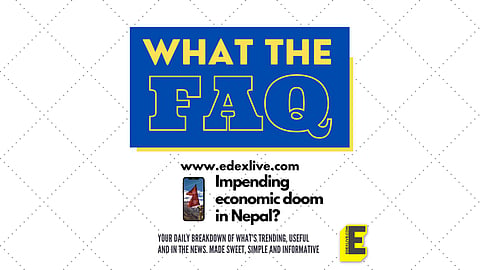

Nepal might soon become the second South-East Asian country after Sri Lanka to find itself staring down the barrel of economic doom.
Fuel consumption is being regulated, inflation is biting the common man hard and the Balance of Payments deficit has surged. While the administration, including Finance Minister Janardan Sharma, claims that the economy is recovering, experts are painting a whole different picture. We take a look at how Nepal got here, and if things are really as bad as they seem.
First, let's look at Nepal's economy in numbers.
Nepal's inflation is the highest it has been in almost six years, at an average of 7.14 per cent. Petrol, imports are in overdrive, and remittance inflows are declining fast. This means that the country's foreign exchange reserves are shrinking to the extent that they may end up lasting for just under seven months for imports.
Currently, the foreign exchange reserves are $9.6 billion down from $12 billion, which was the number just eight months ago. And Nepal's biggest import is petroleum and petroleum products. To check rising petrol prices, and the shortage of funds, the government has put a 20 per cent cap on petroleum consumption. It has also declared that government vehicles cannot ply on holidays.
How did it come to this?
Nepal's import-dependant economy runs on tourism. Much like Sri Lanka. Between COVID-19 and Russia's war on Ukraine, both those factors were plundered. The war impacted fuel prices which have ballooned to an all-time high. Petrol now costs Rs 150 per litre and diesel stands at 133 per litre. Fuel in Nepal is controlled solely by the government-run Nepal Oil Corporation. High petrol prices led to an increase in the cost of consumer goods, and therefore, inflation.
Tourism contributes to 8 per cent of the total GDP, and 6 per cent of the total employment. COVID-19 meant that the tourism sector suffered losses to the tune of $85.2 monthly, according to data by the Nepal Tourism Board.
Apart from these factors, the Kathmandu Post reports that consumers have had to run their households with the same wages as two years ago, which has eaten into their disposable income.
What is the government doing?
To deal with the situation, the Nepal government has increased interest rates. The government hopes this will prevent people from purchasing luxury goods from foreign countries as a measure to check the foreign exchange reserves. Nepal's Finance Minister Janardan Sharma claims that all economic indicators are in the recovery mode, and the country is not facing an economic crisis.
